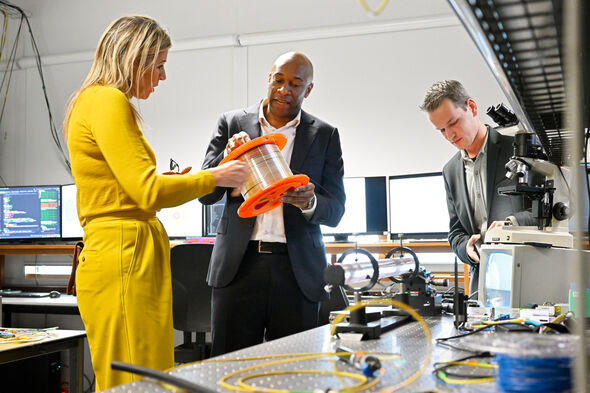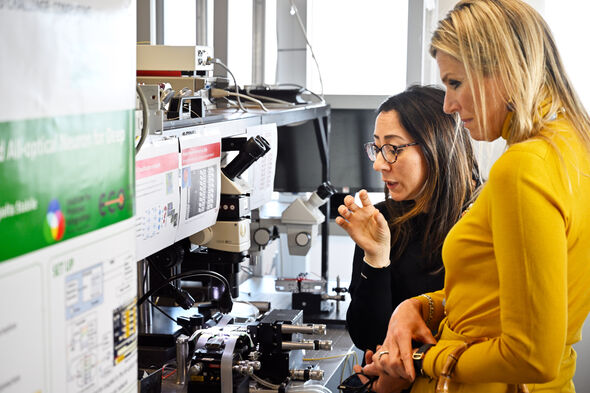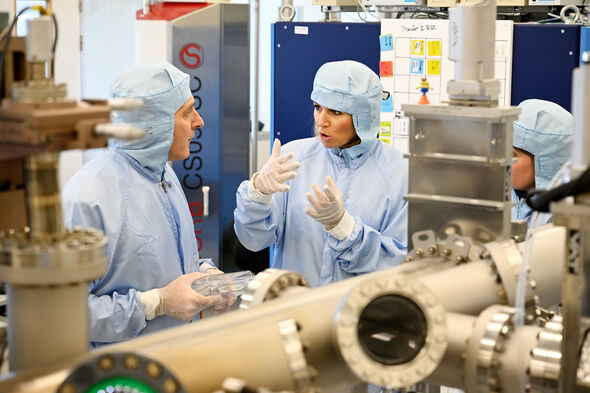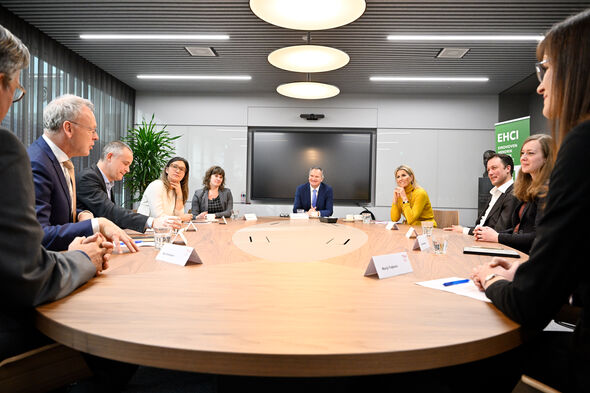
Well-prepared Máxima delves into photonics
The Queen’s visit Thursday to the Eindhoven Hendrik Casimir Institute
Máxima visited TU/e on her own initiative. With the aim of brushing up her understanding of photonics research, she toured various labs, pulled on overalls to take a peek in the cleanroom, and spoke in a round-table discussion about the opportunities and challenges posed by this technology. Students and employees, meanwhile, tried to catch a glimpse of her or take a photo. Flux was unusually crowded and the excitement caused by this high-level visit was palpable.
A few small groups are gathering outside Flux and faces are peering out of the windows when the first police vehicle approaches the building. Next to arrive is the vehicle that everyone is interested in: the car carrying Queen Máxima. She is welcomed by Executive Board President Robert-Jan Smits and Wieteke de Boer, managing director of the Eindhoven Hendrik Casimir Institute (EHCI), who usher her inside for an initial introduction to photonics, a technology used to generate, process and detect light. TU/e is a leader in the field of photonics.
Also joining the group is Kaylee Hakkel, COO of MantiSpectra, a TU/e spin-off that develops light-based detection equipment used to determine the chemical composition of materials. The alumnus has brought along two dishes of chocolate. With the aid of a device that emits infrared light, she shows the Queen how she can determine the percentage of cacao in each piece by pointing the device at the chocolate. Analyzing the composition of materials is one of the many applications of photonics. Another well-known application is the use of fiber optics to transmit data, the field of work of the High-Capacity Optical Transmission Lab run by Associate Professor Chigo Okonkwo.
Under the gaze of the many photographers present, he and postdoc researcher Sjoerd van der Heide tell Máxima how they are able to continually accelerate data processing. “At first, she was holding the very same cable as the one we have running underground. Cables like that contain hundreds, sometimes thousands, of individual optical fibers, each one a slender filament. These fibers have a single core, a channel through which the photons can move. Now, together with other labs around the world, we’re looking at how we can give these optical fibers multiple cores. We showed the Queen an optical fiber containing seven cores; it has 21 times as much capacity as a single-core fiber. Only today one of my students has been experimenting with a similar optical fiber, which has 19 cores. A new record. He’ll soon be publishing his work.”
On the fly
The researcher had not expected the Queen to ask such “surprisingly technical questions”. She asked, for example, whether it was advantageous that photons cannot be stored. “She’s got her facts right: photons can only be processed on the fly. This makes it more difficult to intercept the data. So it can certainly be an advantage in terms of security.” For her part, says Okonkwo, Máxima seemed pleased that the lab’s remit includes the possible abuse of this technology and ways to reduce this risk.
The researcher also told the Queen how training the necessary engineers is made easier by having a suitable laboratory. And how the lab can help companies and startups. “We really are at the heart of photonics here. The university has a leading role, not only in current research but also in shaping future research. A high-profile visit like this one by the Queen helps to spread this message.”
Máxima’s visit takes in the lab run by Associate Professor Patty Stabile at Electrical Engineering. Professor Stabile’s research is in the field of neuromorphic photonics. She tells the Queen that while a supercomputer can carry out the same number of tasks as the human brain, it needs many more times the amount of energy to do so. Integrated photonics can solve this problem, because it enables the processing and transmission of an almost unlimited quantity of data at the speed of light. “The Queen was impressed by the promising results of our research. I found it fascinating that she made the link with neuroscience. It shows that she realizes how multidisciplinary this field of research is.”
Also present in Stabile’s lab is Simone Cardarelli, who tells the Queen about MicroAlign, his startup. Stabile: “Simone and his team are working on how the light from fiber optics can be transferred to chips without losing photons. You could say that this work forms a bridge between Okonkwo’s research and mine. Making the connection between fiber optics and chips is a fundamental step in photonics.”
As well as seeming well-informed and asking “the right questions”, the Queen also came across as simply being a very nice person, says Stabile. “Before she left the lab, she realized that Simone and I are both Italian. So she said – in Italian – that she too speaks a little of the language. It was a nice touch.”
Cleanroom
After visiting the labs, the Queen pulls on a pair of overalls in readiness for a quick tour of the cleanroom in Spectrum. Outside in the corridor, a handful of students are watching through the window. “She looks a lot better in that suit than I do,” jokes one student. More and more ‘accidental passersby’ gather at the window as, on the other side of the glass, Máxima learns from Professor Erik Bakkers about each piece of equipment included in the tour.
“We walked through the cleanroom together so that I could explain the process of producing a wafer; I was carrying one with me. She was well-prepared. She asked whether having to do some things in a vacuum presents any problems. She had good questions.”
Fiber optics
When Bakkers suggested she look at a chip under a microscope and explained that an optical waveguide must always be slightly curved, she recognized the concept from the fiber optics in Okonkwo’s lab. “And she asked whether we’ve ever discovered a new material. We’d just arrived at the equipment in which we discovered the material hexagonal silicon-germanium, silicon capable of emitting light.”
The cleanroom is one of five places in the world where integrated photonic circuits can be produced. A prestigious visit by the Queen helps raise its profile, says Bakkers. “I don’t know whether she’ll discuss what she has seen here when she is back in The Hague, but either way, a visit like this is only ever positive.”
I don’t know whether she’ll discuss what she has seen here when she’s back in The Hague, but either way, a visit like this is only ever positive.
Next up is a round-table discussion with various players in the field of photonics. Among those seated at the table are deans Kees Storm and Bart Smolders, professor and scientific director of the EHCI Martijn Heck, and CEO of PhotonDelta Ewit Roos. Hakkel and De Boer have also rejoined the group, together with recent master’s graduate Bram Smolenaars. Everyone has their say.
Once again, the Executive Board President emphasizes what an important player TU/e is in the field of photonics and that significantly more qualified people are needed in the Brainport region. Shouldn’t these people also be drawn from secondary and higher vocational education? asks the Queen. Perhaps preparation should start as early as primary school? Many of those present agree. And it’s a point that’s mentioned again after the round-table discussion, this time by Storm, Dean of Applied Physics and Science Education. “I really liked what Bram Smolenaars said. He shared his thoughts on what motivates young people to choose a particular study. Increasingly, they’re interested in the positive impact they can have on the world by way of technology. It can be useful to plant that seed early.”
The Queen asks whether the regulatory framework presents any challenges, and whether there are any dedicated standards. And she throws out the question of who might be the launching customer in the near future. These questions aren’t on your radar as a scientist, says Storm. “Oftentimes here at the university, we’re deeply involved in fundamental research, not thinking about how and by whom it will later be used. Máxima mentioned entire industrial sectors we should be getting on board. How, for example, are we going to ensure that these sectors adopt photonics as their new standard. I have to say, it was food for thought.”





Discussion